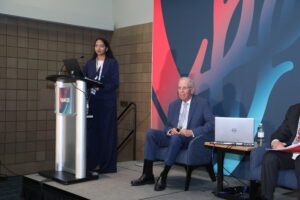
Concerns were raised yesterday’s Plenary Session 2 over the recent decline in Medicare reimbursement at a national level. Querying current figures, speakers revealed discrepancies which highlight the importance of accurate reporting to ensure sustainable provision for the future of vascular care.
Opening the session, Kirthi S. Bellamkonda, MD, and colleagues at the Darthmouth-Hitchcock Medical Center in Lebanon, New Hampshire, briefed the VAM audience on the foundations of their research, outlining that hospitals are reimbursed by Medicare based on diagnostic related groups (DRGs) stratified based on existing comorbidities or in-hospital complications. Medicare severity (MS-DRGs) is used to code each admission as those with comorbidities or complications (CC) or major comorbidities or complications (MCC).
“If a CC or MCC is missed by coding teams, the result is under coding, which substantially reduces hospital payment,” said Bellamkonda. The research team hypothesized that data harnessed from the Medicare-linked Vascular Quality Initiative (VQI) Peripheral Vascular Intervention (PVI) Registry could be used to identify cases appropriate for DRGs with CC or MCC, to avoid underbilling by hospitals.
The research team analyzed 40,822 admissions for Medicare beneficiaries who underwent PVI treatment at 231 VQI centers from 2010–2019. The research team then created a multivariable model to predict whether standard MS-DRG or MS-DRG with CC/MCC was billed for the admission.
Reporting a 0.816 C-statistic for the model, Bellamkonda and team believe they found a “strong predictive association” between the VQI data and current MS-DRG billing. Among key VQI variables associated with CC/MCC MS-DRG billing were dialysis dependence, dependent functional status and congestive heart failure.
In-hospital events included renal and pulmonary complication, amputation during admission and length of stay exceeding six days. “We saw fewer CC/MCC admissions billed than expected in 39% of hospitals, which would have resulted in an estimated total of $9 million in lost reimbursement,” stated Bellamkonda.
She continued: “Based on the accuracy of this model, VQI hospitals could receive a report that estimates the probability that each PVI admission might qualify for DRG billing with CC or MCC. Hospitals could then set their own probability level to select indications for coding review.”
From the audience in encouragement, Linda Harris, MD, SVS president-elect and professor of surgery at the University at Buffalo in Buffalo, New York, urged the team to take this “another step” by prospectively trialing their model in a handful of centers.
“If you can show in say five centers that we have saved you a million dollars here and there that would really make a big difference in promoting the benefits of our C-suite,” said Harris.
Shifting focus to examine Medicare billing as it varies by region and physician specialty, Daniel J. Koh, MD, and colleagues at the Boston University Chobanian & Avedisian School of Medicine, Boston, Massachusetts, specified that Medicare Part B reimbursements have been declining at the national level.
Seeking to identify trends in Medicare reimbursement for endovascular lower extremity interventions, the team consulted the 2018–2022 Medicare Physician and Other Practitioners by Provider and Service dataset for eight lower extremity CPT codes. The data were stratified by setting (facility, hospital vs. non-facility), Centers for Medicare and Medicaid Services (CMS) region, and physician specialty.
In the study period, reimbursement decreased in all but three regions; the Southeast, South and West Coast saw an increase of 1%, 7%, and 9%, respectively. Mountain West and Pacific Northwest regions had the largest declines in facility reimbursements at -19% each. For non-facility locations the average reimbursement was declined in all ten regions, while facility reimbursements declined by an average of -7%.
Out of the eight included procedures, only iliac stent placement (2%), femoropopliteal atherectomy (10%), and infrapopliteal atherectomy (14%) had an increase in facility reimbursements. Intravascular ultrasound (IVUS) and femoropopliteal stent placement had the largest declines at -19% and -17%, respectively. In non-facility settings, the average reimbursement declined by -24%, with femoral-popliteal atherectomy (-43%) and IVUS (-36%) having the largest decreases. Physician specialties all experienced a similar decline in facility and non-facility reimbursements.
Discussant Omid Jazaeri, MD, vascular surgeon at Advent Health in Denver, Colorado added that these data reveal the “disproportionate effect on populations already facing barriers to vascular care” such as those in underserved and rural regions.
He continued, pointing out that Koh’s conclusions “stop short of proposing solutions or policy considerations to mitigate inequities in reimbursement,” advising their research team to recommend areas for “CMS reform, support for providers in high-risk areas or targeted funding opportunities to ensure equity of patient care.”












